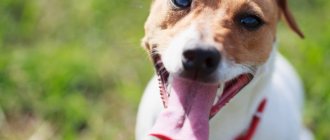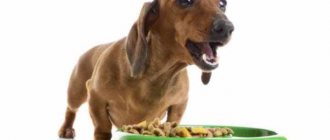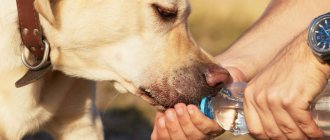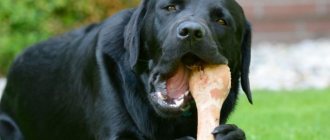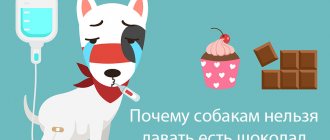Ekaterina Shulga
veterinary therapist
One of the most common symptoms that pet owners bring to the vet is that their dog won't eat. And not surprisingly, this condition is characteristic of many diseases.
- Danger to humans
- Why does a healthy puppy refuse to eat?
It is important to know that refusal to eat and lethargy can be caused by physiological (normal changes in the body that do not require treatment) and pathological (some organs are affected by the disease and malfunction) reasons.
In this article we will learn what to do when a dog refuses to eat and look at the possible reasons for this.
When is it normal to refuse food?
Let's take a closer look at the physiological reasons why a dog doesn't eat.
Boredom and bad mood.
The dog can also be in a bad mood, and if left alone for a long time, it can become bored. Some breeds are more predisposed to emotional mood swings and deal with them differently. Some people become depressed, as a result of which the dog loses their appetite, others find their own entertainment, play with toys, etc.
Environmental factors
, for example, hot weather, can also change the behavior of pets. At high air temperatures, a lack of fluid occurs in the body, as a result of which the dog will be lethargic and may even refuse to eat. These animals need to drink about 50 ml/kg per day, so it is necessary to control the amount of water consumed to avoid dehydration.
Excess weight.
If the number of calories consumed per day is higher than burned, the pet will gain excess weight. And he, in turn, can change the animal’s habitual behavior, it will become less active, and food preferences may change.
Fatigue
- another factor explaining the fact that the dog does not eat and has become lethargic. If on the eve of the symptoms the dog had increased activity, games, training, you just need to give it a little time to rest. Usually, within 1-2 days of rest, the pet’s condition returns to normal, and it returns to its normal rhythm of life.
Conversely, too little activity
may cause loss of appetite. Since the dog has nowhere to put its energy reserves, it reduces the amount of calories it consumes by refusing to eat.
Stress
may also affect appetite and activity. Dogs may be worried about a change of place of residence, the absence of a favorite toy or owner. New family members, guests, new pets, or even the time of year can cause stress. In the fall, dogs are depressed, and in the winter they are cold.
Age
a dog also affects its eating habits and activity. Older pets pay more attention to rest and sleep than to active games. Changes in the body occur gradually and appear at different ages in different breeds. Large dog breeds age faster than miniature ones.
There are behavioral characteristics based on gender characteristics
. For example, an uncastrated male during the period of sexual heat usually eats poorly due to the dominance of mating. Female dogs change behavior during estrus, pregnancy, or in the first days after giving birth. Lethargy, swollen nipples, and an increase in abdominal volume can signal the presence of pregnancy or false pregnancy in the bitch, which explains why the dog does not eat and has become lethargic.
Food quality
also affects appetite. Economy-grade food or dirty water can cause stomach and intestinal upset. The dog will remember this and will refuse to eat or drink in the future. She may also not like the smell or taste of food. You just need to change the water and give a fragrant treat to give your pet an appetite.
Picky eating
- not the rarest reason for refusing it. Some dogs also do not eat from someone else's bowl, someone else's hands, or simply if the food is unusual for them.
Can a dog whine for no reason?
A dog does not whine without a reason - most experts agree on this opinion. The animal makes similar crying sounds to express its pain or anxiety and to interest the owner.
It often seems that if the pet is healthy, then whining is just a bad habit. But there are other good reasons, for example, stress or lack of warmth from a beloved owner. To understand your dog's behavior, pay attention to the details: when he starts moaning, for how long, under what circumstances. Is your behavior at this time calm (lying down, dozing) or anxious?
Possible reasons for refusing to eat and decreasing activity
As we said above, the reasons can be not only physiological, but also pathological. Refusal to eat, lethargy, or changes in the dog’s habits may indicate the development of a disease in the body. Unfortunately, these are very common symptoms and they apply to many diseases. Next, we will look in more detail at the reasons why a dog may not eat well.
Heatstroke
The first signs of sunstroke are very similar to ordinary fatigue. The dog does not eat, drinks a lot, breathes heavily with his tongue hanging out, becomes lethargic, drools profusely and his body temperature rises. Heat stroke is easy to recognize as it is caused by high ambient temperatures, and its symptoms usually appear after long walks in the summer, outdoor exhibitions or training. Heatstroke is a dangerous condition that can lead to dehydration, a surge in body temperature, and even the death of your pet.
Hypothermia
The opposite condition from heatstroke, which can also manifest itself in the fact that the dog lies exhausted and rather lethargic. Her body temperature decreases, her body is in energy-saving mode, because of this, the pet moves little and is not interested in food and toys. The skin turns pale, the sensitivity of the paws decreases, and they become cold.
Liver diseases
The liver, as an organ, plays a very important role in the metabolism of carbohydrates, fats, proteins and vitamins. It also neutralizes poisons that enter the body or are produced in it. If the liver malfunctions, the general condition of the body worsens, the dog does not eat, becomes depressed, drinks and urinates a lot, vomits, diarrhea or constipation, jaundice of the skin, eyes and gums, and the volume of the abdomen increases.
Kidney diseases
The kidneys are the main organ where urine is produced and blood proteins are filtered. With kidney disease, the dog does not eat, rarely urinates, arches its back and reacts aggressively to palpation of its back. Her condition becomes depressed, her temperature rises, the volume of urine excreted decreases, and vomiting often progresses. The animal's skin becomes dry and inelastic, and the smell of acetone appears.
Diseases of the gastrointestinal tract
Obstruction, gastritis (inflammation of the stomach), enteritis (inflammation of the intestines) cause pain, flatulence and bloating. The causes of diseases can be an incorrect diet, viral and bacterial infections, genetic predispositions, intolerance to food components, eating foreign bodies or constipation. Symptoms of such conditions: the dog does not eat, it has vomiting, diarrhea or, conversely, there is no stool, the stomach is tense and painful.
Oncology
Cancer occurs in dogs of all ages—puppies and adults. Often it occurs latently for a long time, or its symptoms are disguised as other diseases. With the development of cancer, in addition to visible tumors, symptoms such as apathy, increased abdominal volume, changes in breathing, periodic fever appear, and the dog also does not eat.
Viral infections
When a virus enters a dog’s body, its immune system tries to fight it. As a result, the temperature rises and the dog does not eat. There are several viral diseases that are common in our country. These are parvovirus enteritis, canine distemper, hepatitis, rabies, leptospirosis, canine parainfluenza. Their accompanying symptoms depend on the affected body system - cough, nasal discharge or loose stools, and vomiting may occur.
Oral diseases
All pathologies of the oral cavity are accompanied by painful sensations. Inflammation of the gums, deposits of tartar and, as a result, destruction of tooth roots, development of gumboil, exposed tooth canals - all of them can be reasons for refusing the usual food.
Pathologies of the chest cavity
The thoracic cavity contains the heart, lungs, bronchi, trachea and esophagus. These are life-supporting organs and if they do not perform their function in full, the dog’s general well-being deteriorates. In addition, shortness of breath, exercise intolerance, cough appear, the type of breathing changes, the dog breathes with its stomach.
Pain or itching
Itching, redness, scabs, inflammation on the skin, any pain - the dog feels all this, like a person. Therefore, if you remember yourself when something hurts or is constantly itching, you will understand why the dog does not eat and changes its behavior.
Diseases of the osteoarticular apparatus
Any changes in muscles, joints and ligaments cause discomfort to the pet. The dog becomes lethargic, does not eat, has stiffness in movements, and lameness. The pet refuses its usual movements - climbing stairs, jumping. He may also have an unsteady gait.
Poisoning
If a dog does not eat, has diarrhea, vomiting, or a high temperature, it can be assumed that this is poisoning. Throughout life, a dog can encounter many poisons - food, household chemicals, medicines, plant poisons from indoor plants and poisons on the street. Symptoms of poisoning will depend on the type of poison and which organ it affects.
Parasitic infestations
There are a huge number of parasites in the world that a dog can become infected with at any age and at any time of the year. There are internal parasites - helminths, as well as external ones - fleas, mosquitoes, subcutaneous and ixodid ticks. Mosquitoes and ticks can carry internal parasites that attack the heart, blood cells, and muscles. Any parasite can be the reason why a dog is not eating.
Probable causes based on accompanying symptoms
Symptoms that indicate the reason that the dog does not eat, does not drink, but only lies.
| Causes | Symptoms |
| Overabundance of nutrients |
|
| Stress |
|
| Ear diseases |
|
| Gastrointestinal diseases |
|
| Oncology |
|
| Foreign body |
|
| Post-traumatic shock |
|
Diagnostics
A dog’s poor appetite is just a symptom of an illness, and recovery requires a diagnosis. To do this, research needs to be done. During the examination, the veterinarian usually makes a preliminary diagnosis, determining where the problem is localized: in the abdominal or chest cavity, muscles, bones, mouth or skin. Next, the specialist prescribes an examination.
Abdominal examination
, will help identify diseases of the gastrointestinal tract, liver, kidneys of various etiologies - viral, bacterial, endocrine. The abdominal cavity is examined using ultrasound (ultrasound diagnostics) and X-ray examination, where the specialist describes what the organs look like, whether their structure is changed and whether foreign bodies are present. Blood tests (clinical and biochemical) will show how organs are working and determine whether there are signs of inflammation or problems with red blood cells.
Chest examination
is performed using x-rays; if heart pathology is suspected, then it is supplemented by ultrasound and ECG. Blood tests will show whether a problem with the lungs or heart is affecting other organs. After all, the heart delivers blood to all organs, and the lungs fill the blood with oxygen; with diseases of the lungs and heart, all structures of the body will suffer.
Muscles and bones
They are examined with X-rays; if it is necessary to assess the consequences of extensive injuries, ultrasound is used.
For skin examination
When diagnosing itching, skin scrapings, cytology and trichoscopy (fur examination) will be required.
oral disease may be suspected.
. To verify this, just examine her mouth. As a rule, this is how you can see the main problems or diseased teeth. In the latter case, the patient is sent to see a dentist, the specialist will prescribe sanitation of the oral cavity with tooth extraction or additional studies in the form of dental photographs.
After standard tests have been carried out, there may be a need for more specific studies. For example, oncocytology - when a tumor is detected, fluid culture - if a bacterial infection is suspected, PCR diagnostics for viruses or examinations under anesthesia in the form of endoscopy (insertion of a camera to visually inspect an organ).
Hurry up, choose a box and find out what gift awaits you
Discount on pet insurance
Promo code copied to clipboard
Danger to humans
Most often, dog diseases are not dangerous to humans, but it is still worth observing personal hygiene measures and protecting yourself. This is important if you have symptoms of diseases such as:
- Worm infestation.
Some parasites can be transmitted from dogs to humans and vice versa. For example, these are liver flukes (flukes, schistosomes), cucumber, pork tapeworm, roundworms, pinworms, tapeworms, hookworms.
- Ixodid tick bites.
The dog itself will not infect you with anything, but ticks can fall from its body and crawl onto a person.
- Viral diseases.
For example, rabies is a deadly disease that has no cure in either humans or dogs. Infected pets are immediately euthanized, and the person dies in agony.
- Bacterial infections.
For example, leptospirosis, which is caused by bacteria and affects the liver, kidneys, muscles, and nervous system.
As we can see, not many dog diseases threaten humans. Avoiding them is quite simple - you need to regularly vaccinate your dog and treat it against external and internal parasites.
Treatment
Conditions in which a lethargic dog does not eat or drink require active treatment, and this will vary greatly depending on the causes. Treatment is prescribed individually in each individual case, but there are some general rules that apply to a particular group of diseases.
In case of heatstroke
It is urgent to cool the pet by covering it with wet towels, covering it with ice and eliminating all stress.
In case of hypothermia,
on the contrary, you need to warm up, try to feed and drink warm food, and create peace.
For liver diseases
therapy is aimed at preserving the performance of hepatocytes (the main cells of the liver), replenishing vitamins and fluids in the body. Antibiotics are often prescribed. A very important factor for recovery is restoration of appetite; for the liver to function, the dog must eat its minimum daily caloric intake.
To restore kidney function
Water balance in the body is very important. Therefore, intravenous drips and drugs are prescribed to correct anemia, and protein intake in food is reduced to facilitate kidney function. This is important because the kidneys produce a special hormone that affects the production of red blood cells - erythrocytes. They carry oxygen to organs that cannot function without it. Unfortunately, the kidneys are not a recoverable organ and if more than 70% of the kidneys are affected, therapy may not help and any treatment will not be effective.
In the treatment of gastrointestinal diseases
use different tactics. If the cause of the disease is foreign bodies or tumors, surgery and, in some cases, chemotherapy are necessary. In other cases, gastroprotectors, drugs to accelerate intestinal motility or, conversely, to slow it down, antibiotics, sorbents and droppers are used.
With the development of viral diseases
It is necessary to maintain immunity, so immunostimulants and vitamins are prescribed. Symptoms of infection are relieved with antiemetics, antibiotics and IVs.
When a bacterial infection develops
in the chest, abdominal cavities, and reproductive organs, a course of antibiotics and symptomatic medications will be offered. For example, if pneumonia (bacterial pneumonia) develops, oxygen therapy, bronchospasmodics, and drugs to thin the mucus in the lungs will be prescribed.
If there is pain
in muscles, bones, joints, analgesia is prescribed - non-steroidal anti-inflammatory drugs, restriction of mobility, muscle relaxants. Then they may prescribe rehabilitation in the form of massages, swimming or physical exercise.
For the treatment of heart disease
specific therapy is used that increases heart contraction, drugs to lower blood pressure, and diuretics.
If the reason for refusing to eat is parasites
– helminths, subcutaneous mites, fleas or intracellular parasites; after they are identified, drugs are prescribed to treat this particular type of parasite.
How to get your appetite back
If your dog has no appetite and no health problems, try following these tips:
- Put away food and bowls, skip a few meals
and don’t give in to begging for treats. All dogs have primary instincts, and this will not allow the body to starve. Once your pet is hungry enough, he will agree to eat food from his bowl.
- Do not leave food in the bowl after your dog has eaten.
Clean up any leftovers before the next feeding time.
- If the dog does not have gastrointestinal problems, allergies, give a lightly salted piece of fish or meat 15–20 minutes before feeding
. Salt will increase the feeling of hunger. But don’t get carried away - this is one-time advice; it is not recommended to do this on an ongoing basis.
- Walk your dog more and play.
This will allow her not to get bored and burn calories.
- Create competition
Offer food to another pet in front of a picky pet. Dogs are greedy and don’t like to share food, toys or the owner’s attention, so they will immediately show interest in what they gave to a competitor.
- Change your diet.
Sometimes it is necessary to change the brand or flavor of food, or add a new type of porridge to stimulate the dog's appetite.
How long can a dog go without eating, what are the dangers of starvation?
How dangerous fasting is for a dog depends on its physical condition. A healthy animal that regularly receives food and water can go without food for up to 14 days (provided that it drinks enough water). In the absence of not only food, but also water, a dog can live for about 7 days . An animal weakened by illness and poor nutrition can live for a week without food, but if there is no water, then the life expectancy in this state will decrease to 4 days.
If we consider breed characteristics, it should be said that short periods of fasting are natural for working and hunting dogs; they do not have a negative impact on their health. Decorative dogs do not tolerate lack of food well and quickly fade away.
Prolonged fasting is equally dangerous for any breed of canine. Animals develop dystrophy and suffer from disturbances in the gastrointestinal tract. The first sign of a serious problem is failure of the hind legs. Then the front legs stop moving, the functioning of the internal organs is disrupted, which can result in the death of the animal.
What to do if your puppy doesn't eat well?
If the puppy refuses to eat, it is better to immediately consult a veterinarian. A puppy is a child, and everything in its body is different from an adult dog. Hunger for more than a day will become critical for the baby, and irreversible processes will begin in the body. The most common reasons for refusal to eat in babies are viral infections and abdominal pain due to problems with digestion of food in the developing intestines. In such situations, full veterinary care is needed - intestinal medications, antibiotics, infusion therapy.
If the puppy eats poorly, chooses food, but is active, drinks and agrees to treats, try to sort out his diet. Most likely, something is preventing him from eating properly - too much kibble, unsuitable food, too high a caloric portion, problems with stool, or not enough play and activity.
Why does a healthy puppy refuse to eat?
If your puppy is in good health and is not eating well, take a closer look at how he behaves while eating. Perhaps there are objective reasons for refusing food.
- Wrong food.
More precisely, food not intended for puppies. After all, the jaw sizes of a puppy and an adult dog can differ greatly. Therefore, it is necessary to select the size of the granules specifically for your pet. Many manufacturers offer such food. Most major brands have dry and wet food for dwarf, medium, large and even giant breed puppies.
- Lack of regime.
A puppy needs to be fed 3-4 times a day, an adult dog - 2 times a day, observing certain feeding hours and portion sizes. You may be feeding your pet too often or giving him too large portions.
- Frequent food changes.
In search of the best food, owners often change brands. This poses two threats: firstly, the pet can get used to frequent changes and constantly wait for something new. Secondly, a sudden change in food can cause digestive problems in the animal.
- Treats and food from the table.
Treats in a dog’s diet should be limited in quantity; they cannot form the basis of the pet’s diet. Chocolate, sausage, cheese and other similar treats are strictly prohibited. This way you are not only pampering your pet, but also harming its digestive system. If you want to give your pet treats, then choose ones specially made for dogs.
How to train a puppy to eat food
The transition from one type of food to another should be gradual. Mix a little new food into the old food, gradually increasing the proportion of the second. This way you will avoid a hungry protest from your pet.
A fairly radical method is to show the animal that the food in the bowl is his only choice. This method is only suitable for dogs that do not have stomach problems. Nutritionists recommend that during feeding, put the food in a bowl and leave for half an hour to an hour. If your dog doesn't touch the food, remove the bowl until the next meal. Make sure that no one in the household feeds the dog during this time! Don't be afraid that she will remain hungry. The animal may not eat for a couple of days, the main thing is to have a bowl of drinking water nearby.
In fact, a dog does not require variety in food; it is ready to eat one type of food all its life if it is balanced and nutritious.
How does the disease progress?
Once the infection process has occurred, the disease remains in a latent stage for a number of days. At this time, it will not be possible to identify symptoms in your pet. The virus begins to actively invade the cells of the pet’s body and rapidly multiply.
The average incubation period is a week. It happens that the duration reaches three weeks; in lightning cases, the incubation period can be reduced to two days. Although the seasonality of the disease has not been scientifically proven, cases of distemper in dogs are often recorded in the fall or spring. During the incubation period, no signs of the disease can be detected in the dog. However, the animal is already contagious and spreading the infection around itself. Even after recovery, the dog releases the virus into the environment for weeks.
The risk group for developing the disease includes small puppies, weakened animals that do not have normal nutrition. If a puppy is fed with mother's milk for up to 2 months, the baby has antibodies in its body received from the mother, the risk of infection in this case is minimal.
Prevention
Follow the schedule of vaccinations, treatments for parasites, and be examined by a doctor (dispensary examination) at least once a year. Medical examination is especially important for pets over 6 years old, because by this age most dog breeds are elderly, and it is necessary to regularly evaluate the functioning of their body.
Do not ignore recommendations on animal hygiene for dogs, such as washing bowls, a suitable bed that needs to be washed and patted regularly, feeding and watering standards. The food must be fresh and of high quality, the water must be clean and filtered. And many foods familiar to humans are poisonous to dogs - for example, grapes (and raisins), chocolate, avocados, spices, pickles, sausages, mushrooms, onions, garlic, alcohol. They need to be excluded from the dog’s diet once and for all.
Eliminate hazards at home, put household chemicals and medicines in locked cabinets, and if your dog is cunning and can open them, you need to hang a lock. Buy toys according to the size and character of the dog so that it does not swallow or chew them. Close the windows and balcony, dogs also jump from heights. Clean your home regularly.
And, of course, don’t forget about friendship with your dog. You mean the whole world to her, and she is always waiting for you to walk with her, play, pet her and chat. If you don't have enough time for a pet and you think she's bored, get a second one, they'll have more fun together.
Check your dog regularly – eyes, ears, fur, mouth. Use veterinary cosmetics for your pet’s hygiene and do not forget that the veterinarian is your assistant in caring for your dog.
Useful tips
If for some dogs whining is a necessary measure, they rarely resort to this method of communication, then others are very emotional by nature. Such breeds need to be raised from childhood, otherwise feelings will overwhelm them in any ordinary situation.
Some useful tips on how to stop your dog from whining all day:
- Teach from an early age that there is no need to express emotions violently (barking, whining). If such overexcitation occurs, switch the dog to games or training (active action).
- If changes are planned, such as moving or having a child, be as attentive as possible to your pet. Show care, spend time with him, be sure to take your favorite toys and bedding to a new place.
- Plan your pet's daily routine so that it satisfies its physical activity. Remember that a Pug and a Jack Russell Terrier have different exercise needs. Active breeds need to run, jump and move a lot, otherwise they will waste their energy destroying the apartment.
- Make your pet's corner cozy and suitable for him: a comfortable bed, a large number of toys. Assess your friend's temperament: some dogs love privacy, a soft, semi-closed house is suitable for them, while others want to have a lot of fun, for them choose toys that squeak, rustle, and run away.
- Be prepared for what the animal is afraid of. For example, fireworks or thunderstorms. In the first case, on major holidays, when a lot of fireworks go off, it is better to lock the dog in a dark, quiet room, for example, in a bathtub, after putting a bowl of water there and putting a bed down. In the second case, when it is difficult to predict natural phenomena, try to be nearby, hold and stroke the dog.
You will make your life much easier if you accustom your pet to a routine from an early age. Then he will know that at a certain time you walk, then eat. That you are not at home during the day, but you come back and spend time with him, play in the evening. With this kind of training, the dog will know when and what to expect.
In conclusion, it must be said that the most important thing when frequent whining appears is to make sure that the dog is healthy. Pay attention to little things, behavior, if alarming symptoms appear, do not wait until they worsen, consult a doctor immediately. Otherwise, remember that animals, regardless of age, are children, they need your support and care.
Loss of appetite and lethargy of the dog: the main thing
- The cause of the condition is important - physiological or pathological; this determines whether the dog needs to be treated.
- If the problem is physiological, simply observe the dog and, if possible, correct its behavior.
- If the problem is pathological and a disease may develop, provide first aid to your pet and consult a veterinarian.
- If you doubt whether it is a disease or just a picky dog, consult a doctor. Usually, even just by collecting anamnesis, the doctor can understand whether the pet is sick.

